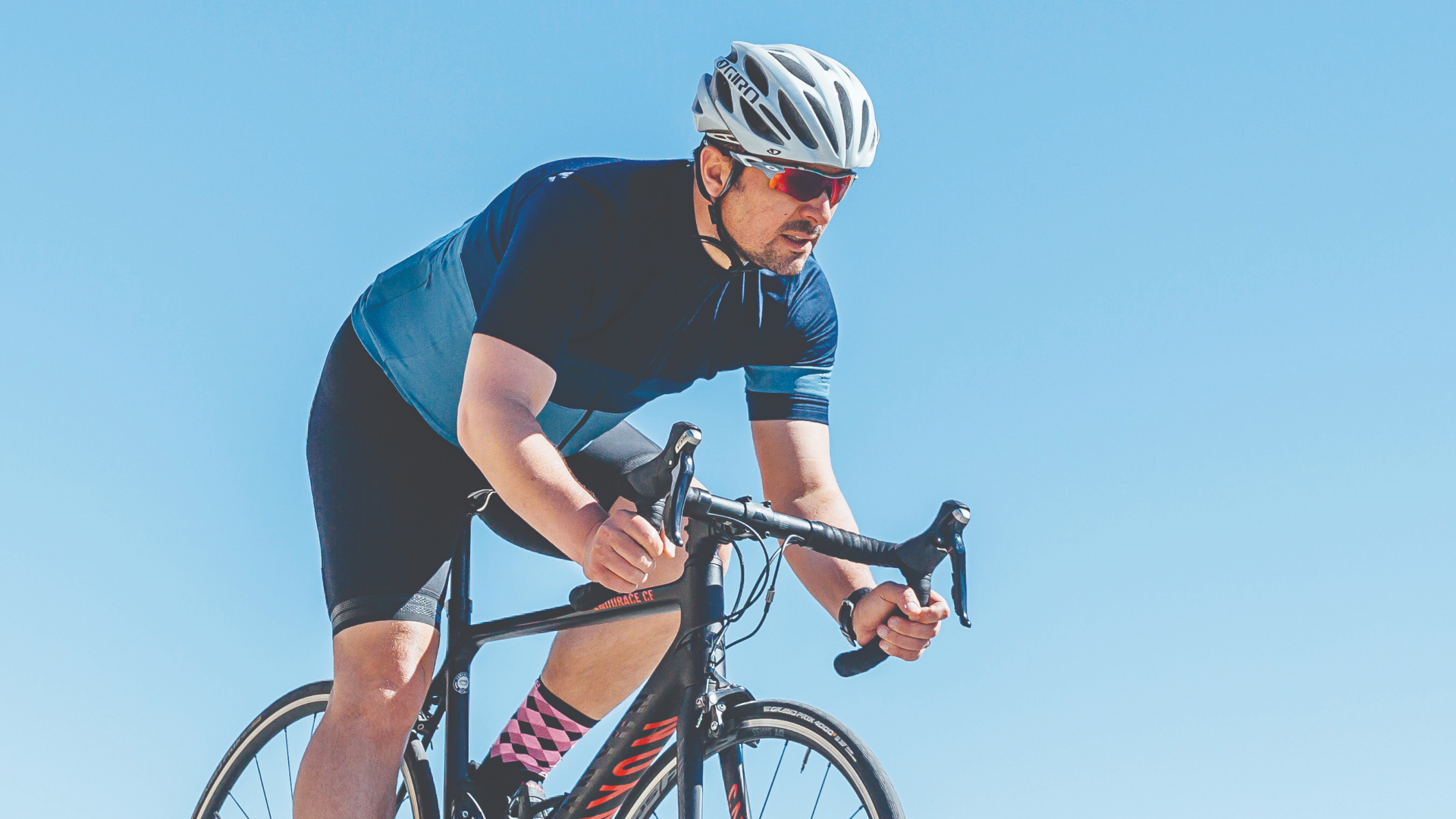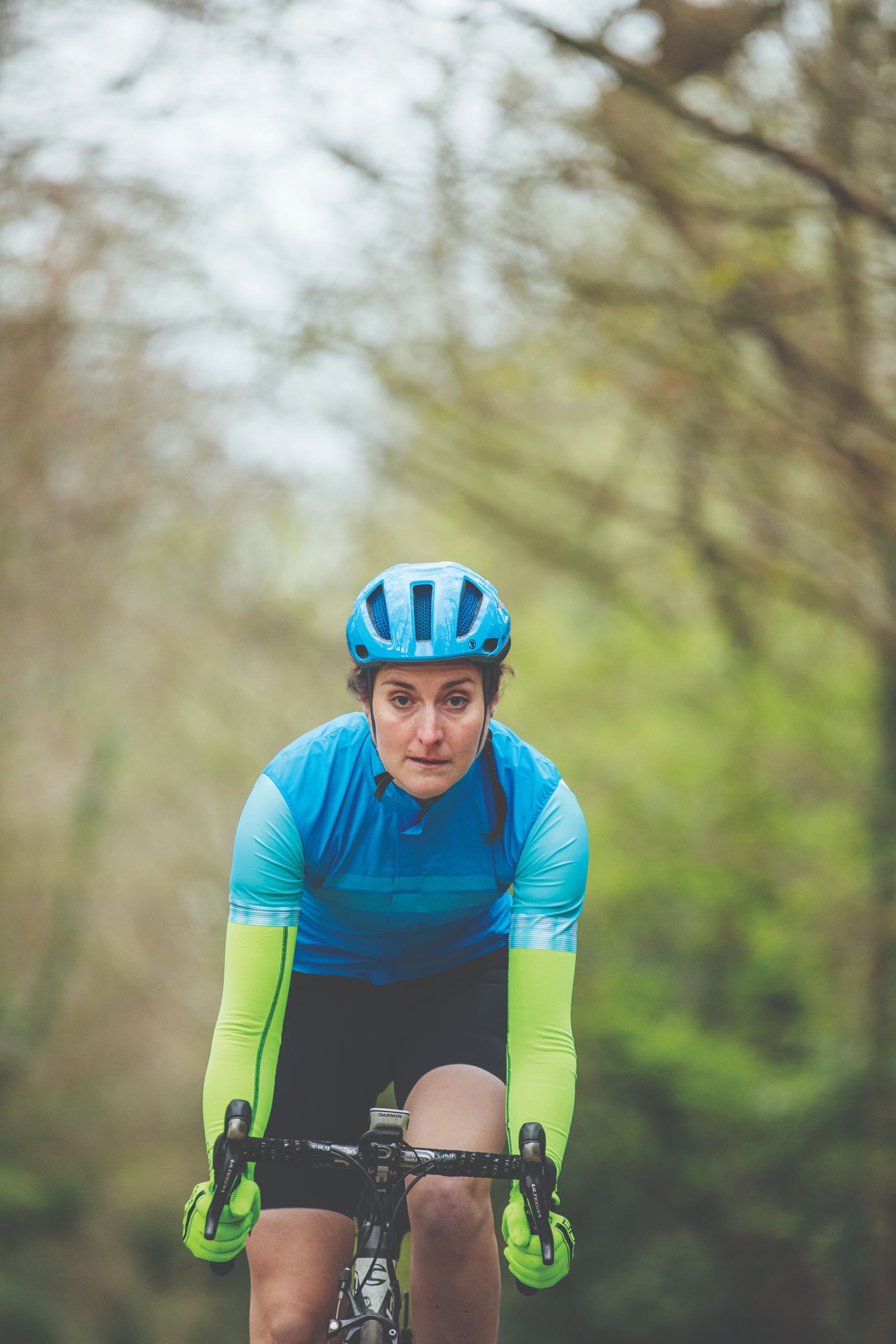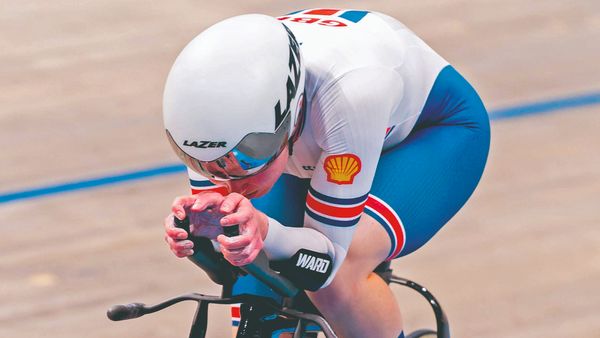
Arriving back at my front door, I leaned heavily against the jamb. Despite the discomfort, there was a small swell of pride at what I’d just achieved, and now I was ready for a very long sit down. We’ve all been there at the end of a long ride, exhausted and aching, the sofa beckoning. But I wasn’t returning with 100km in my legs. Rather, I had hobbled the 50 metres to the end of my road and back without a walking stick, for the first time in months.
My back issues had set in over a period of weeks and months in 2019 as I attempted to keep riding through yet another round of disc-related niggles. Lifting weights in the gym only succeeded in making things worse. By mid-July I could barely ride; by the end of the month, I had to stop. The next time I rode a bike was mid-November, and a five-minute spin at 85 watts on the turbo was all I could manage. At that point, after four months of complete rest, my fitness levels were almost certainly the worst they’d ever been, not just because of the lack of cycling, but the lack of any movement at all. I refused to let go of the belief that one day I would be OK – my back would eventually recover. But what about my cycling fitness and form – what would it take to get that back?
In this feature, I want to investigate exactly what happens to our fitness when we rest and detrain, and how long we can expect to have to work to get that fitness back. Detraining and retraining are concepts most cyclists are familiar with. We know that even after taking a week or two off for a holiday, we don’t feel as sharp as we did before. Most of us have at some point taken longer off the bike owing to illness or injury, and have then discovered that the comeback is not quite so straightforward. Grudgingly, we attempt to ease back in.
For pro cyclists, collarbone breaks and worse are part and parcel of making a living – time off followed by a rebuild of form is a familiar foe. With full-time doctors and coaches closely monitoring their comebacks, they often manage to hit form again surprisingly quickly. It took Visma-Lease A Bike star Wout van Aert just two months, for example, to return to top-level racing after a devastating crash in the spring Classic Dwars door Vlaanderen, which saw him break his collarbone, sternum and seven ribs. At his comeback race, the Tour of Norway last month, he was not on sparkling form, but he finished the four stages without any pain – a key recovery marker.
The cause of detraining isn’t always a crash or injury. Elite road racer Alice Lethbridge, for example, spent a long time returning to form last year after contracting Covid in January. The Lightning Cycling Team rider was fully off the bike for around 10 days with numerous false starts, but it took her nearly a year to recover her pre-Covid fitness. “I was really unwell, and it had a huge impact on my breathing,” says Lethbridge, a biology teacher. “I was at the point where I couldn’t even get up and walk around the classroom at work without feeling out of breath.”
The turning point came when she met a consultant who suggested she push harder sooner, but less often. “This is because, when you have a virus, the inflammatory molecules that your immune system releases are the same ones that endurance training releases,” Lethbridge explains. This creates an ongoing state of inflammation, meaning the body struggles to recover, she learned. But higher-intensity intervals are different. “Interestingly, shorter, harder intervals lead to a different sort of inflammatory response in the body.” The approach turned things around for Lethbridge, and she was finally able to get back to riding. Her experience suggests that if we are coming back from a virus, we could do worse than to dispense with longer, low-intensity riding and instead try shorter, harder efforts but with plenty of recovery time in between. Fasted riding can also increase inflammatory markers, Lethbridge learned, so don’t go hungry while you’re trying to come back from illness.
Another rider forced to take a long break is Ian Kear-Bertie. The 44-year- old Cotswolds rider was hit head-on by a car that turned right without warning last September, breaking his collarbone and ribs and puncturing a lung. “After the accident, my immediate thoughts were, I’m suddenly going to lose all my fitness and I’m gonna have to start all over again,” he says. As it turned out, Kear-Bertie was back on the indoor trainer a fortnight later, the sling on his arm carefully strapped to a joist in his shed to immobilise it, knocking out a cautious half-hour spin.
Those first spins on the turbo assuaged Kear-Bertie’s fears about his fitness levels, discovering that his power had remained at a reasonable level, with his upper body movement and breathing the chief limitations. He set himself a goal of taking on an outdoor ride – with all the accompanying upper body dynamics, road vibrations and even risk of falling – by the end of the year. Sure enough, on 27 December: “I plotted a 60km route past the crash scene,” he says. “It was an emotional ride. As I went past it was like a reset. I thought: ‘Everything from here onward is now new’.”

Anyone who has struggled during the last miles of a long ride knows that the mind plays a major role in cycling. It begins with the perception of effort. Dr Tim Noakes’s classic ‘central governor’ theory, for example, postulates that it is the mind that controls the limits of our efforts.
Dr Samuele Marcora of the University of Kent believes that our physical limits are affected by our perception of effort, and with regard to detraining, he says: “There is for sure one psychological effect that is going to impair exercise tolerance: an increase in perception of effort.” In other words, you have to some extent ‘forgotten’ how hard it feels.
There are some tried and tested steps returning riders can take to make their comeback easier. It starts with the acceptance of their lower fitness level. “I said to the coaches, can I lower my FTP?”, says Alice Lethbridge. “As soon as I did I felt I could make a bit more progress, because I wasn’t constantly feeling bad.” Lethbridge also recommends using process goals to maintain momentum. Ian Kear-Bertie took a similar approach: “Having goals and targets was a real driver,” he says, citing his first indoor and outdoor rides, and first 100km ride.”
What is detraining?
However you end up detraining, the loss of form tends to happen in a predictable way. The first alteration is a change in blood volume, explains Professor Charlie Pedlar, professor of applied sports and exercise science at St Mary’s University in Twickenham. An increase in blood plasma is one of the fastest training adaptations, followed by a more steady increase in oxygen- carrying haemoglobin. “The reverse happens when we detrain,” says Pedlar, “so we see a fairly rapid decrease in that blood-water element, and then a gradual change in the haemoglobin mass as well, as that gradually comes down.” For the rider on a comeback, this loss of blood volume manifests as a higher heart rate for a given power output. Quickly regained, blood volume is the least of your worries.
A 2016 study carried out by Pedlar et al – Cardiovascular response to prescribed detraining among recreational athletes – demonstrated that marathon runners lost 6% of blood plasma compared to peak fitness following a four-week detraining programme. It also showed that the heart shrank, with walls and chambers reducing in size. Moving to muscular endurance, this is partly down to mitochondria, the minute organelles that are responsible for generating energy using oxygen. The efficiency, as well as the density, of mitochondria is something else that can be trained and detrained surprisingly quickly.
After a restful week, “musculoskeletal-wise, you might feel fine,” says Dr Jamie Pringle, an associate professor in exercise physiology at the University of Birmingham, “but there’ll be certain things that will have changed. The only thing that changes quite quickly up and down is the chemistry of the mitochondria, [owing to] various enzymes that are responsible for how energy is shifted around and used.” As soon as training stops, the mitochondrial benefits from cycling start to fade, but like blood volume they are quickly reinstated once training resumes.
Fitness characteristics that are lost more slowly include muscle capillarisation. The capillaries that carry oxygenated blood to the muscles “are surprisingly quick to adapt in response to load,” says Pringle. “You’re talking about a handful of weeks before you start seeing new capillary growth.” Both capillarisation and mitochondrial activity were measured in a 1984 study by Ed Coyle et al. Assessing well-trained endurance athletes 12, 21, 56 and 84 days after cessation of exercise, the study found that, in fact, capillarisation remained the same during that time – 50% above the sedentary control. However, mitochondrial enzymes citrate synthase and succinate dehydrogenase declined with a 12-day half-life, eventually stabilising at 50% above the sedentary control. The same study also demonstrated significant effects on VO2 max, which fell 7% in the first 21 days, but more promisingly stabilised after 56 days at 16% above the sedentary control level.
While certain elements of detraining – and recovery – happen faster than others, precise numbers vary from individual to individual depending on genetics and their individual situation. How you spend your time away from the bike plays a major part. In particular, bed rest brings about a faster decline and, on the off-chance that you’re taking a break from cycling to become an astronaut, space travel is ruinous. “There have been a lot of studies on astronauts where you take away gravity, and you see a rapid loss of function,” Pedlar says. The reason for the accelerated decline in both these scenarios is the absence of the surprising amount of work our bodies do simply staying upright and moving around between daily tasks.

Building the comeback
You’ve lost some fitness, so how to get it back? It depends. Two weeks off the bike for a holiday where you are staying active requires a different style of comeback than a fortnight spent in a hospital bed battling crash injuries. It’s personal too, both in terms of physiology and perception. Some of us might feel that we can hit form again quickly, while others fear it’s going to take aeons to get that fitness back. In truth, though, the elements that fall off faster are also recoverable faster.
Pedlar says: “I would think of [detraining] as a declining curve of fitness, with a long, flat section. You’re going to get down there quite quickly, plateau for a number of weeks, but then it’ll continue to decline.” What we do
know is that fitness can be maintained by comparatively small amounts of exercise compared to what it may have taken to achieve in the first place. For example, a 2021 review – Maintaining Physical Performance’ by Spiering et al – concluded that endurance fitness could be “relatively well-maintained in general populations despite relatively large reductions in exercise frequency (up to 66%) and volume (33–66%), as long as exercise intensity is maintained.” Encouragingly, especially if you are on holiday or a work trip and can’t take the bike, “If you spend just a few minutes a day doing interval training, that’s sufficient to keep blood volume elevated and mitochondria relatively high,” Ed Coyle stated in a New York Times interview earlier this year.
When it comes to taking a complete break from riding, the rather unfortunate news is that those who have built the most fitness have the most to lose “in absolute terms”, said Coyle, a kinesiology professor at University of Texas. The good news is that our muscles retain a ‘memory’ of exercise (see box), so all things being equal, it should be easier to regain fitness than it was to achieve it.
Surprisingly, Coyle says that 50% of fitness can be regained within 10-14 days by including regular hard workouts. After that, how long it takes to get back to 100% depends on how much you started with. That’s not to say it’s a great idea to dive straight into heavy training after a long break. Trainsharp coach Jon Sharples suggests a very low level to begin with. “Slowly build it up in week one,” he says. “Just 15, 20 minutes, 30 minutes, 40 minutes and get yourself to an hour. It definitely takes three weeks before you feel like a cyclist again.” Sharples reckons he can get most riders back up to their best in three months after a break. “What I cannot do is make you lose weight,” he says. “If you’ve piled on the pounds, that needs a bit of strategic planning.”

Detraining
After 12 days - 50% fall in mitochondrial enzymes.
After 21 days - 7% reduction in VO2 max.
After 28 days - 6% reduction in blood plasma; heart shrinking.
Maintaining
33% of usual volume can maintain fitness levels for 15 weeks (provided intensity is retained).
Retraining
Start with very small
amounts in week one.
10-14 days – up to 50% of fitness regained.
12 weeks – up to 100% of fitness regained.
Starting out again
Alice Lethbridge took considerably longer to return to full fitness than did Ian Kear-Bertie. Interestingly, though, the biggest drop-off reported by both riders was in endurance. “That was one of my major strengths,” says double 12-hour national champion Lethbridge, “but an hour-and-a-half, two hours at my old 12-hour pace, was exhausting me.” Kear-Bertie, for whom 100-mile rides were pre-crash bread and butter, had a similar experience. “I think it was in early February that I did my first 100km since the crash,” he says. “I really felt that, towards the end.” It wasn’t until late April that he completed the first 100-miler of his comeback.
Lethbridge’s comeback was more complex because of the elite level to which she was striving to return. “In training you can’t get the effect of the micro-adjustments you have to make in racing – so the only way to actually get yourself race-fit is to race,” she says. That’s exactly what she did, and following one false start at the end of April, she raced again in May – the first event she finished.
Although Lethbridge, Kear-Bertie, and indeed I, have different stories and different recoveries, the optimistic upshot is that we did all recover full fitness. It took me around a year to brave my first 50-miler, but unlike for my fellow rehabbers, that was no small ride for me. As for the walking stick, it’s gathering dust in a corner somewhere, my back now pain-free. My experience with sciatica certainly keeps the mind focused when it comes to stretching and core exercises, but thankfully these days I can reach the end of the road unaided. In fact, I’m usually on my bike.










